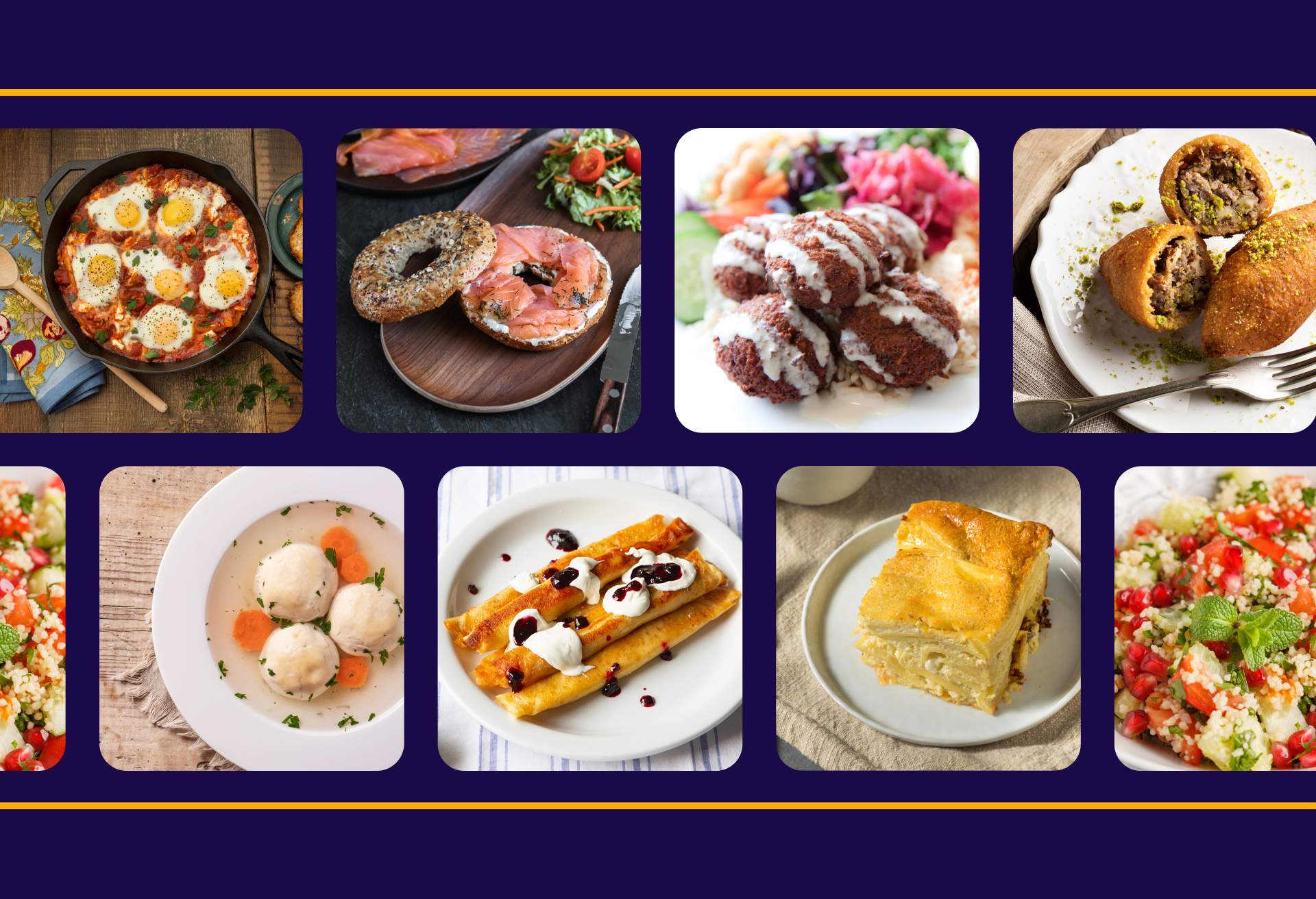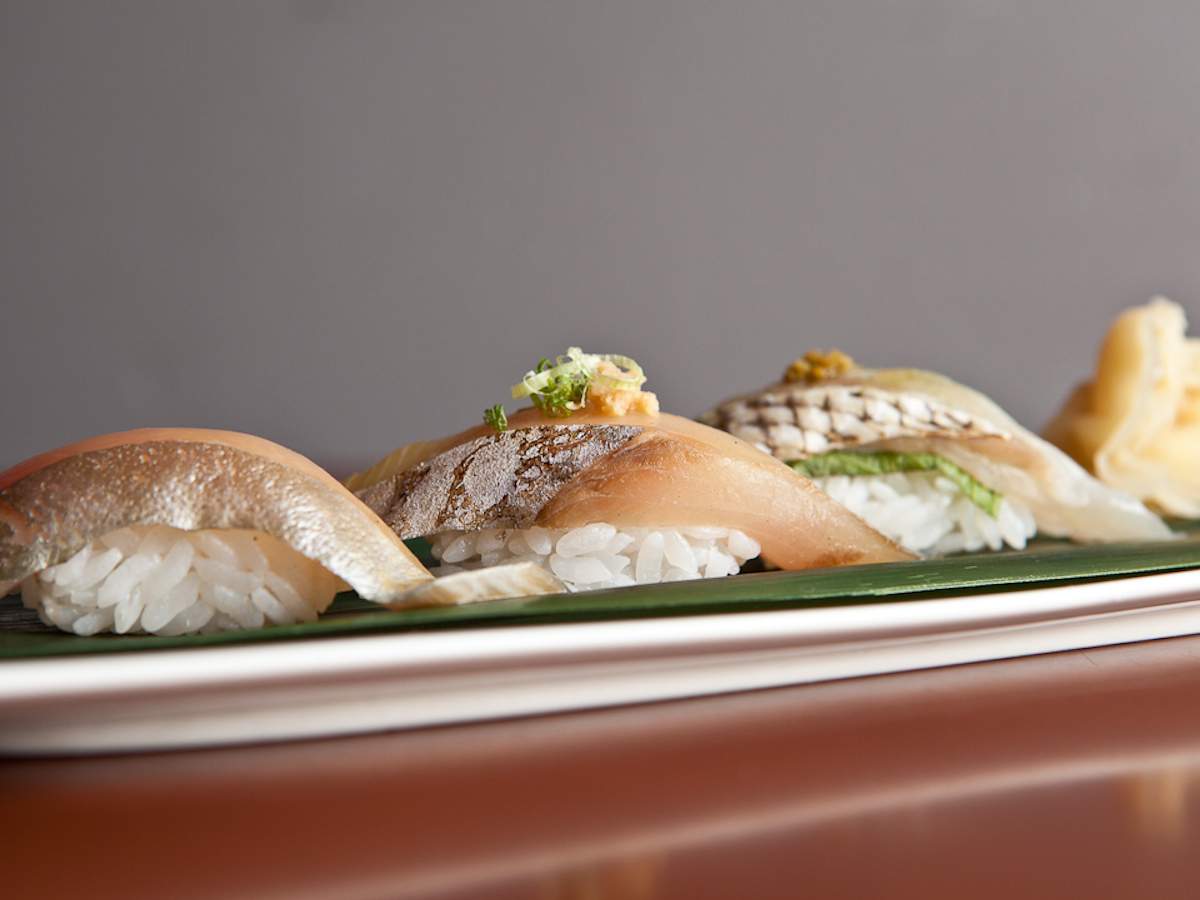“Jewish food” is a fairly fluid category. The Jewish people have lived all over the world for centuries, so their recipes have countless geographic influences. For example, gefilte fish (poached ground fish cake) is consumed during the Passover holiday, but it’s a staple for Polish Catholics, too. Sufganiyot, the jelly doughnuts some Jews eat on Hanukkah, are popular in many countries, including Libya, where Muslims eat them around the time of Ramadan. And while many Jews keep kosher—following a set of dietary rules from the Torah that prescribe not mixing meat and dairy in the same meal or eating pork, among other regulations—others happily eat bacon cheeseburgers and consume Jewish foods as a way to stay connected to their culture.
All of this is to say: Jewish food is a melting pot of flavors and global cultures. For Jewish American Heritage Month, we’re celebrating some popular Jewish dishes, from Ashkenazi (descending from France, Germany, and Eastern Europe), Sephardic (descending from Spain, Portugal, North Africa, and the Middle East), and Mizrahi (descending from North Africa and the Middle East) traditions, including matzo ball soup, kibbeh, and noodle kugel, and highlighting OpenTable restaurants across the United States that serve them.

This North African dish became an Israeli staple after Jewish immigrants brought it to the country in the latter half of the 20th century. The warming, saucy fare exploded in popularity in the U.S. over the past decade and now appears on restaurant menus across the country. The traditional recipe calls for simmering poached eggs with tomatoes, garlic, and onions, as well as with spices, including cumin and paprika, but the one-pan entree can withstand all kinds of modifications—various cheeses, spice swaps, and eggs cooked in any style. Vegan versions feature chickpeas instead of eggs, while other recipes replace tomatoes with green vegetables. No matter the ingredients, it’s always a crowd-pleaser.
Where to find shakshuka: LAW at Four Seasons Dallas in Dallas, Nook in Tucson, and Zalman’s on Woodward in Bloomfield Hills, Michigan

This breakfast trifecta—bagels; cream cheese (also called schmear); and lox, or smoked salmon—is quintessential Jewish food and an iconic fusion of flavors and textures. The bagel’s roots can be traced back hundreds of years to Eastern Europe; the word “bagel” comes from the German for “bracelet”—possibly because the hole in the middle allowed for easy transport of multiple bagels on a rope or rod. The smoking or curing of fish is a popular preservation technique in many parts of the world, going back to pre-refrigeration days; this practice, too, entered Jewish cooking in the U.S. more than 100 years ago, thanks to Jewish immigration waves from Eastern Europe.
Where to find bagels and lox: Angeline’s in Charlotte, Accent in New York, and The Kennison in Chicago

This deep-fried Middle Eastern street food is a favorite in Israel and beyond. About as prevalent there as chain coffee shops are in North America, falafel stands hawk the crispy ground chickpea balls stuffed into pita or lafa (a flatbread that’s a little thicker than pita) with an array of fixings: tahini, cucumbers, pickles, French fries, and charif (hot sauce). What’s more, the dish is pareve, meaning it’s prepared with neither milk nor meat, so Jewish people who observe kosher laws can eat it anytime. In the United States, falafel is a popular option on menus in Mediterranean and Middle Eastern restaurants.
Where to find falafel: Bosphorous Turkish Cuisine in Orlando, Maroun Mediterranean Grill in Seattle, and Layla in Miami Beach

Though noodle kugel is usually baked in a casserole dish and cut into squares, it held a different shape in the Old World: “Kugel” comes from the German word for “ball.” Also called noodle pudding, this sweet dish, as it’s typically prepared now in the United States (savory versions are more popular in other parts of the world), features egg noodles and cottage cheese. It’s served on many special occasions, including after Yom Kippur—one of the holiest days of the year. To satisfy your noodle kugel cravings, either score an invitation to an Ashkenazi Jewish grandmother’s house, or, if you’re in the Los Angeles area, hit up one of the OpenTable spots below.
Where to find noodle kugel: Birdie G’s in Santa Monica and Lovi’s Delicatessen in Los Angeles

A staple among Sephardic and Mizrahi Jews, kibbeh, a savory, deep-fried treat from Syria and Lebanon—it’s Lebanon’s national dish—is popular Middle Eastern street fare. Though it resembles falafel, kibbeh is made from bulgur, pine nuts, and either beef or lamb; it’s also more difficult to prepare. Before deep frying it, the cook must shape it into a little football, or torpedo. The final product is crispy on the outside, hot and soft with a dash of cinnamon on the inside. Try kibbeh straight out of the deep fryer with a drizzle of tahini, or ground sesame seed paste.
Where to find kibbeh: Leila in Washington D.C., Terra Mediterranean in Dallas, and Byblos Restaurant in Boston

Known as Jewish penicillin, this chicken soup with dumplings is comfort in a bowl. According to Jewish lore, it will cure whatever ails you, but it’s soothing when you’re healthy, too. Matzo balls, or “knaidlach” in Yiddish (a historic Jewish language), are made of matzo meal, the ground version of the unleavened bread Jews eat on Passover, and held together by eggs. The broth typically includes pieces of chicken, carrots, and fresh dill. Because it can be kosher for Passover, matzo ball soup is an important part of the holiday, but it’s also served at Shabbat dinners and in traditional delicatessens.
Where to find matzo ball soup: Celebrity Delly in Washington D.C., Tiny’s & The Bar Upstairs in New York, and Doc B.’s Restaurant + Bar in Chicago

Although Israelis simply refer to it as “chopped salad,” this refreshing side dish accompanies just about any Israeli meal. Like many Jewish foods, Israeli salad is an important part of other cuisines, as well, and goes by many names, including Arab salad. Israeli salad has a number of variations, but the basic one combines diced cucumber, tomato, and onions; a dressing of lemon juice and olive oil; and a sprinkling of za’atar, a flavorful Middle Eastern blend of dried herbs, toasted sesame seeds, dried sumac, salt, and other spices.
Where to find Israeli salad: The Cave Kosher Bar & Grill in Fort Lauderdale, Hummus Bar & Grill in Los Angeles, and Sant’Olina in Los Angeles

These pancakes, or crepes, rolled up around cottage cheese, fruit fillings, potato, or meat, are a holiday favorite. They’re traditionally served on Shavuot, the Jewish celebration that once marked the harvest of wheat. This Eastern European treat is topped with applesauce, sour cream, or berries. Blintzes are best eaten fresh, but if you find yourself with extras, freeze them to prepare a casserole later; the sweet version tastes like a soufflé and is ideal for breakfast or dessert.
Where to find blintzes: Brooklyn Diner in New York, Revel in Pittsburgh, and Hawthorn in Dallas
Diana Spechler is a novelist and essayist whose work appears in The New York Times, The Guardian, Washington Post, Harper’s, and elsewhere.




